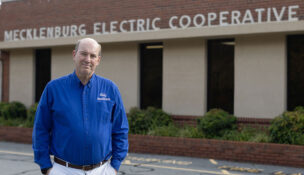Report: More cuts needed to meet net zero by 2050
State will need to capture and sequester 40M tons of CO2
Report: More cuts needed to meet net zero by 2050
State will need to capture and sequester 40M tons of CO2
Clean energy policies enacted in Virginia put the state on the path to cutting carbon emissions, but the commonwealth likely won’t reach net zero emissions by 2050 without more work, according to a new report released Monday by U.Va.‘s Environmental Resilience Institute.
The report set carbon dioxide emissions reductions mandated under the 2020 Virginia Clean Energy Act (VCEA) as a baseline for helping to determine additional mitigation needs. If the state implements current policies under the act, it will still need to capture and sequester 40 million tons of carbon dioxide from the atmosphere per year if it wants to reach net zero for greenhouse gas emissions by 2050.
“The good news is, is that we have lots of pathways to get to net zero and some of them … need more work, but they have the promise of being cost-effective,” Leon Szeptycki, an author of the report and associate director of U.Va.’s resilience institute told Virginia Business. “And one of those pathways which will almost certainly be necessary is taking carbon out of the atmosphere, because there are going to be emissions that are just too hard to cut. Reducing the amount of carbon in the atmosphere also … at least creates the possibility that [it] will hold climate change to manageable levels.”
The state Department of Environmental Quality estimates that the commonwealth currently emits about 140 million tons of carbon dioxide-equivalent greenhouse gases annually, according to the report. Transportation is the biggest contributing sector, totaling nearly 49 million tons, followed by industry at 25.2 million tons and commercial and residential at 24.7 million tons and 23.7 million tons respectively.
Forests and other natural strategies help to remove about 50 million tons of that. But relying on natural strategies, including reforestation and agricultural practices as well as wetland and seagrass restoration, won’t likely be enough. The report says such strategies could help sequester or mitigate an average of 8.6 million tons of carbon dioxide in addition to what they’re currently providing.
Former Gov. Ralph Northam and other state lawmakers lauded the VCEA as putting the commonwealth at the forefront of other Southern states for helping to combat climate change. Chief among its headlines are net zero goals for electricity production for Dominion Energy Inc. by 2045 and others by 2050. But some of those efforts have become a target for Republican lawmakers, emboldened by the shift in the power balance in the House of Delegates and the election of Gov. Glenn Youngkin in November 2021.
To comply with the mandates, Richmond-based Dominion, the state’s largest energy producer, has focused initiatives on solar and other projects, including the construction of a $9.8 billion offshore wind farm being constructed off Virginia Beach’s coast. While U.Va.’s report accounts for such mandates in its report, it doesn’t account for other possible changes, including a rollback of the VCEA or other state or federal measures, or, for example, shifts in transportation trends.
The report is intended to offer an initial look at possible pathways for responding to climate change, Szeptycki said, adding that in a connected economy, it’s difficult to look at Virginia in a vacuum. He said he hopes researchers will do additional looking into potential solutions and the impacts of those to communities.
“I think the good news is, it’s something that, if we put our minds to it, we could get to net zero by 2050, which is kind of amazing when you think about how much fossil fuels we burn,” he said. “And, we can do it at a manageable cost. The trickier thing, though, is how much work it will take to get there, and it will take a lot of work.”
t















